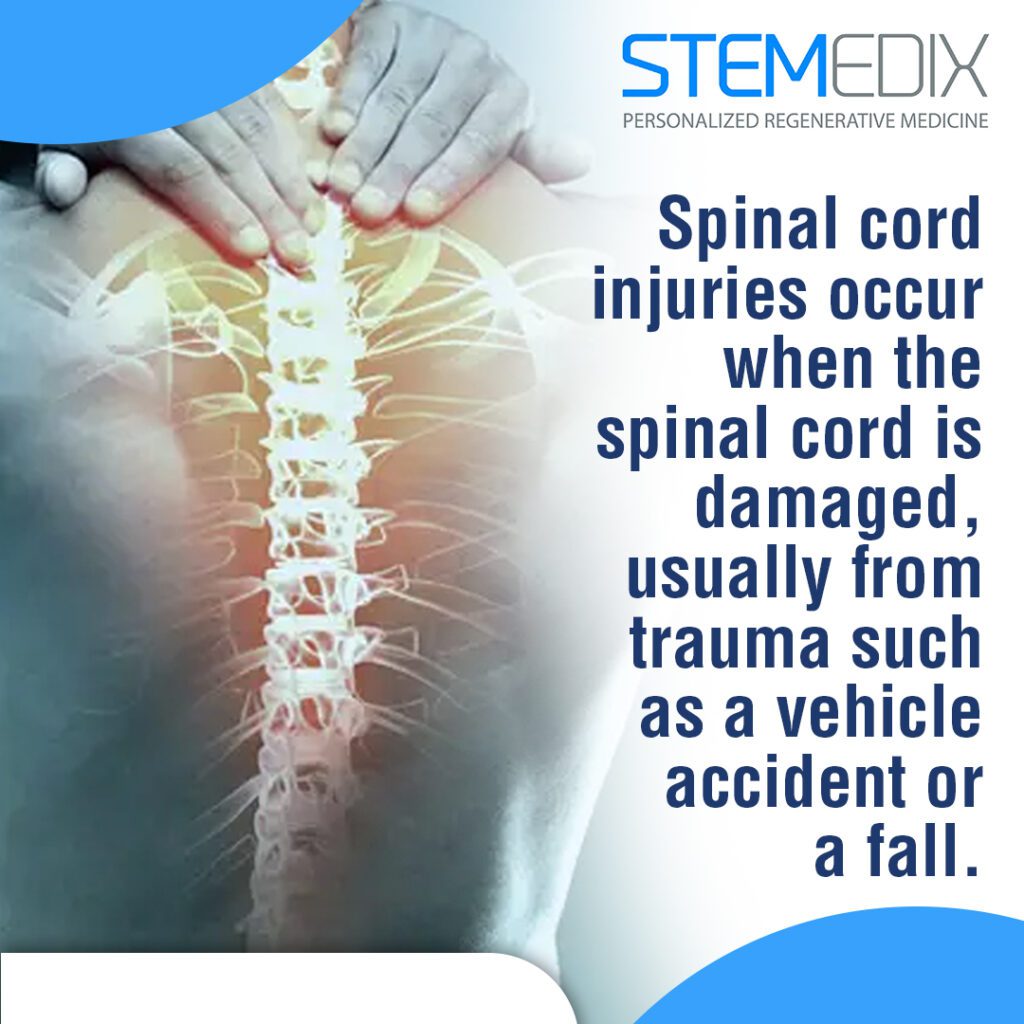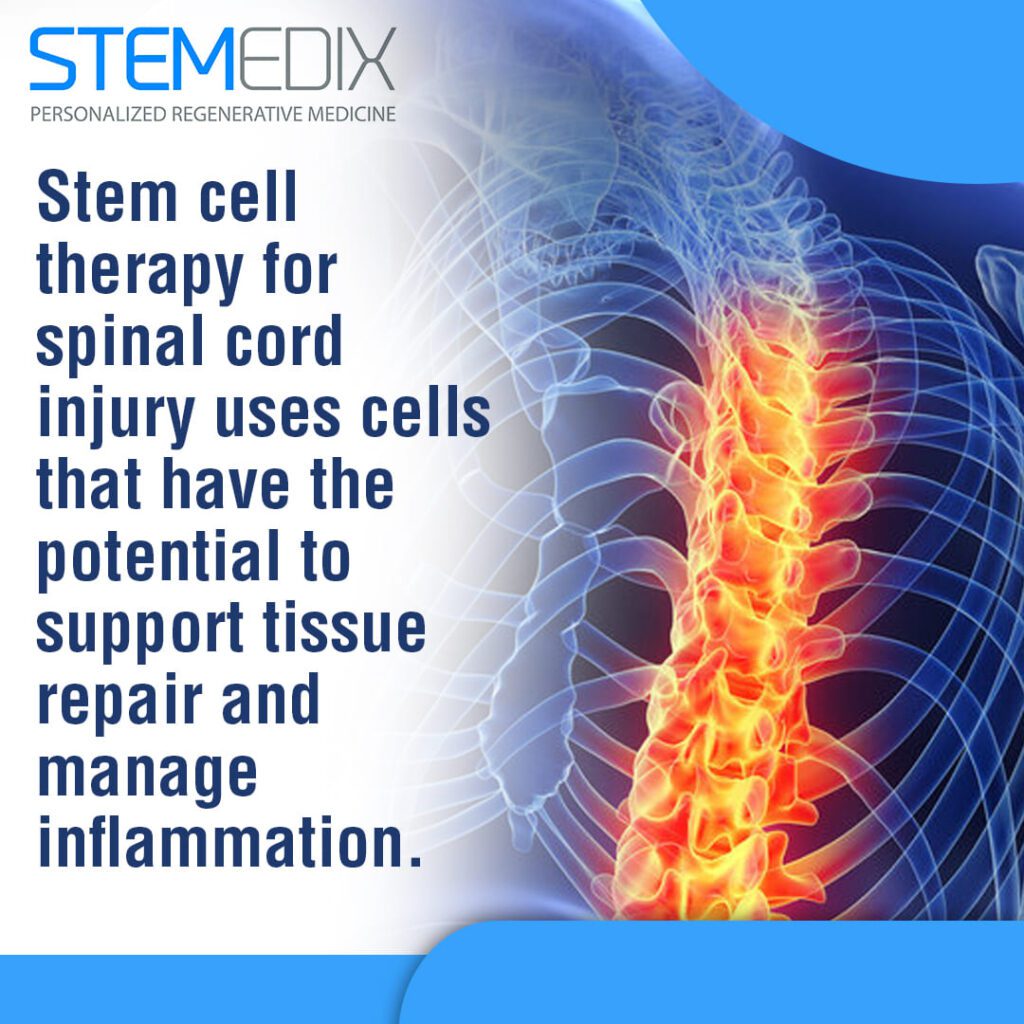Living with a spinal cord injury changes how you move, feel, and function every day. You might be searching for more support in your recovery or looking into alternatives when other treatments have plateaued. At Stemedix, we provide access to regenerative medicine options, including stem cell therapy for spinal cord injury, designed to support your body’s healing potential. Our goal is to help you maintain independence and improve your quality of life through individualized care.
Stem cells for the treatment of spinal cord injury are being explored for their ability to support damaged nerve tissues and help reduce symptoms related to mobility, pain, and function. This therapy is not a cure, but it may serve as another layer of support in your recovery process. In this article, we will discuss how spinal cord injuries affect the body and how stem cell treatment may fit into your path forward.
Defining Spinal Cord Injury: Causes and Impact
A spinal cord injury doesn’t just affect mobility—it changes how the entire body communicates, functions, and adapts. Knowing how these injuries happen and what they cause can help you better plan your care and treatment options.
Common Causes of Spinal Cord Injury
A spinal cord injury is most often caused by sudden trauma or underlying medical conditions that disrupt nerve communication within the spine. These injuries commonly follow events such as vehicle crashes, major falls, sports-related impacts, or violent encounters.
Other cases develop from non-traumatic sources. These include conditions like spinal tumors, multiple sclerosis, and certain infections that interfere with the spinal cord’s structure and function. Degenerative diseases—such as spinal stenosis or arthritis—can also contribute to gradual nerve damage over time.
A spinal cord injury disrupts messages between the brain and the rest of the body. Where the injury occurs determines what parts of the body are affected. For example, if damage happens in the cervical spine, it can interfere with both arm and leg function. A lower injury in the lumbar region, by contrast, may impact only the hips and legs.

Immediate and Long-Term Effects on the Body
A spinal cord injury can result in paralysis, loss of sensation, and autonomic system dysfunction. Right after the injury, you might notice loss of movement, reduced feeling in certain areas, or changes in bladder and bowel control. These effects often appear quickly and may be temporary or permanent, depending on the severity.
As time passes, new challenges can appear. You may notice muscle weakness from disuse, skin breakdown from reduced movement, or respiratory changes if the injury is high enough to affect breathing muscles. Pressure injuries, also called pressure sores, and recurrent infections such as urinary tract infections are common secondary complications that require careful management. These long-term impacts highlight the importance of continuous support and well-structured care plans.
Classification of Spinal Cord Injuries by Severity and Location
Knowing where and how a spinal cord injury occurs helps you and your care team decide on the right approach to managing your recovery. The level and type of injury directly impact physical abilities, personal care needs, and long-term health planning.
Complete vs. Partial Injury Overview
A complete spinal cord injury causes total loss of motor and sensory function, while a partial injury retains some level of nerve signal transmission. If you’ve been diagnosed with a complete spinal cord injury, it means there’s no communication between the brain and the body below the injury site. This disconnect leads to full paralysis and loss of sensation below that point.
In contrast, partial, also called incomplete injuries, allow some signals to continue traveling along the spinal cord. You may notice that you still have some sensation, or you may be able to move certain muscles. These residual functions vary greatly between individuals. This classification matters because it plays a role in setting realistic goals for therapy and rehabilitation.
Differences Between Cervical, Thoracic, and Lumbar Injuries
The location of a spinal cord injury determines which parts of the body are affected. Cervical injuries often result in quadriplegia, thoracic injuries affect trunk and leg function, and lumbar injuries primarily impair lower limb control and bowel or bladder management.
Cervical injuries, those in the neck region, are often the most severe. They can impact movement and feeling in all four limbs, including breathing, swallowing, and arm function. These types are the most likely to require long-term assistive devices or full-time care.
Thoracic injuries occur in the middle section of the spine. While they typically spare arm movement, they may limit balance, torso strength, and control over abdominal muscles. It may be harder to sit upright or regulate body temperature below the injury level.
Lumbar injuries involve the lower spine and tend to affect the legs and lower body systems. Many people with lumbar-level injuries retain upper body function, but mobility challenges and changes in bladder or bowel function often follow. This type of injury may still allow for independent movement with the use of braces, walkers, or wheelchairs.
At Stemedix, we review all available medical records to understand your specific injury type and level before recommending any regenerative treatment option. This allows us to align our approach with your needs and current capabilities.
Stem Cell Therapy Explained: Purpose and Methods
Stem cell therapy for spinal cord injury involves introducing regenerative cells to promote repair and protect surviving tissue. These cells are introduced into areas near the injury site, where they may influence several healing processes. One of the primary actions is the regulation of the immune response, which helps reduce further damage caused by ongoing inflammation. In addition, stem cells may release biological signals that support the health of existing nerve cells and encourage the development of new connections within the nervous system.
Types of Stem Cells Used in Therapy
Stem cells for the treatment of spinal cord injury may sometimes include mesenchymal stem cells (MSCs), neural stem cells, and induced pluripotent stem cells (iPSCs). Each type works differently, but MSCs are the most frequently used in current therapeutic models. These cells are typically harvested from bone marrow or adipose (fat) tissue. They’re known for their ability to regulate inflammation and release molecules that promote healing.
Neural stem cells, on the other hand, are more specialized and are under investigation for their ability to integrate into damaged neural circuits. Induced pluripotent stem cells, adult cells reprogrammed into a more flexible, embryonic-like state, are still largely in the research phase. Although they offer broader potential, their use requires rigorous safety protocols to manage risks like tumor formation.
At Stemedix, we focus on therapies that use stem cells for the treatment of spinal cord injury with strong safety records and established handling procedures. Our team works closely with patients and referring physicians to coordinate care that is both informed by current science and centered on individual medical history.
Biological Actions of Stem Cells in Nerve Repair
Stem cells offer more than just cellular replacement—they create conditions in the body that support repair and healing. When applied to spinal cord injury, their effects can influence both immune activity and tissue regeneration.
Influence on Inflammation and Immune Response
Stem cells help regulate immune responses and reduce secondary damage from inflammation. After a spinal cord injury, inflammation can lead to further damage beyond the initial trauma. Immune cells flood the site, often destroying nearby healthy tissue in the process. This secondary damage can be just as limiting as the original injury.
Stem cells interact with this process by releasing bioactive molecules like cytokines and growth factors. These signals tell immune cells to calm their response and shift toward tissue support instead of attack.
This immune-modulating activity helps preserve nerve cells that might otherwise deteriorate. You’re not just adding cells—you’re also working with your body’s existing systems to limit further harm and stabilize the injury site.
Role in Regenerating Damaged Neural Tissue
Stem cell treatment for spinal cord injury may support the formation of new neural connections and repair mechanisms. Spinal cord damage disrupts the flow of signals between your brain and body.
To support repair, stem cells may promote three biological processes: axonal growth, remyelination, and cellular restoration. Axonal growth refers to the extension of nerve fibers that transmit signals. Without axons, communication between nerves stops.
Remyelination involves restoring the protective sheath around nerves, which allows electrical impulses to travel efficiently. In cases of spinal cord injury, this sheath often breaks down, leading to slower or blocked signals.
Studies show that certain types of stem cells, including induced pluripotent stem cells (iPSCs) and MSCs, can release growth factors that encourage axons to regrow and remyelinate existing nerves. These biological effects don’t occur all at once. They build over time as the cells interact with damaged tissue, guiding regeneration step by step.
At Stemedix, we focus on regenerative strategies that support your body’s efforts to recover. Stem cell therapy for spinal cord injury is structured to work with your body, using natural signaling processes to support healing at the cellular level.
Observed Outcomes from Stem Cell Treatments
Many individuals exploring regenerative options want to know what to expect from stem cell therapy. While results can differ, this section outlines some of the most reported effects based on real patient experiences and clinical data.
Enhancements in Mobility and Sensory Recovery
Some patients receiving stem cell treatment for spinal cord injury report improved strength, coordination, and sensation. These outcomes are often influenced by the level and completeness of the injury. For example, individuals with incomplete spinal cord injuries—where the spinal cord is damaged but not fully severed—have demonstrated positive changes in limb control, trunk stability, and tactile feedback following therapy.
Certain patients experienced measurable improvements in motor scores and sensory function within months after receiving stem cell injections. These functional changes, although not universal, suggest that the cells may support the body’s effort to reconnect or reinforce neural pathways.
The timing of intervention also plays a role. People who began stem cell treatment in the sub-acute phase (weeks after injury) have shown different patterns of recovery compared to those in chronic stages. It’s important to consider that early intervention may help maximize the biological environment for healing, but research is still ongoing to determine the full scope of response across timelines.
Reduction of Discomfort and Muscle-Related Symptoms
Stem cells have been observed to reduce spasticity and neuropathic pain associated with spinal cord injury. Spasticity, which causes involuntary muscle contractions, and nerve-related pain are among the most persistent challenges following spinal trauma. These symptoms can disrupt sleep, limit mobility, and interfere with rehabilitation.
Some patients who received mesenchymal stem cell (MSC) therapy reported decreased muscle stiffness and better pain control. Stem cell infusions modulated the immune response and contributed to reduced inflammation around damaged spinal segments. This shift may help explain why pain and tightness sometimes improve after treatment.
Relief from these symptoms can create opportunities for more active daily routines and improved engagement in physical therapy. While stem cell therapy is not a replacement for traditional pain management or rehabilitation, it may complement those approaches in supportive ways.
At Stemedix, we’ve seen that outcomes vary depending on the person’s overall health, injury characteristics, and treatment timing. Our role is to offer access to care designed around your condition while helping you understand how regenerative therapy might fit into your goals for living with a spinal cord injury.
The Treatment Process at Stemedix: Patient-Centered Approach
Every individual with a spinal cord injury presents a unique medical profile. At Stemedix, based in Saint Petersburg, FL, we align the treatment process with your personal health history and therapy goals to support your experience from evaluation through follow-up.
Importance of Diagnostic Information From Referring Physicians
Stemedix requires patients to provide medical imaging and records from their diagnosing physicians to determine eligibility for stem cell therapy. We rely on your existing records—such as MRIs, CT scans, and clinical summaries—to fully understand the scope of your spinal cord injury. This information gives us a starting point to evaluate whether stem cell therapy may be appropriate for your situation.
A detailed medical history helps our team determine the location and severity of your injury while also providing insight into how your body has responded to previous interventions. Accurate documentation from your physician allows us to move forward responsibly and reduce avoidable risks during the treatment process.
Tailoring Treatments to Individual Medical Histories
Each stem cell treatment for spinal cord injury is customized according to the patient’s health condition, injury level, and treatment goals. We look at a range of personal factors before planning treatment. These include the type of spinal cord injury you’ve experienced—whether complete or incomplete—as well as how long it has been since the initial trauma. Conditions like diabetes, autoimmune disorders, or chronic infections, as well as the medications you’re currently using, are all taken into account.
Administration Protocols and Safety Measures
Stemedix uses sterile, clinically guided protocols for administering stem cells. Each procedure is conducted in a controlled medical setting under the direction of trained clinicians. We use laboratory-tested biologics and sterile techniques to lower the risk of complications. All patients are closely observed before, during, and after the procedure.
Throughout treatment, we document patient responses, both for clinical records and to support communication with your existing care team. This consistent monitoring helps track progress and contributes to adjusting your care as needed over time. According to clinical studies, stem cell therapy has been associated with neurological improvements in some individuals with chronic spinal cord injuries, especially when introduced within a defined therapeutic window.

Patient Support Beyond Therapy
Recovery involves more than medical treatment alone. At Stemedix, we understand the physical and logistical challenges you may face when dealing with a spinal cord injury. That’s why we help coordinate accessible transportation and lodging for patients traveling from out of town, easing the burden of planning and focusing attention on your care.
To support your comfort during therapy, we provide access to mobility aids like wheelchairs and walkers, along with personal assistance when needed. Our team creates an accessible environment that allows you to move through treatment with as much comfort and independence as possible.
Start Your Recovery Journey with Stemedix Today
If you’re exploring advanced treatment options for spinal cord injury, our team at Stemedix is here to guide you every step of the way. We offer patient-focused care, treatment coordination, and support services designed around your individual needs. To learn more or speak with a care coordinator, call us at (727) 456-8968 or email yourjourney@stemedix.com.


 St. Petersburg, Florida
St. Petersburg, Florida
